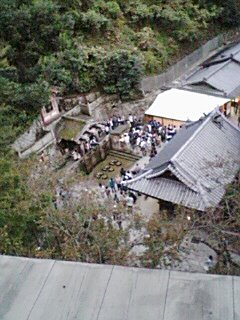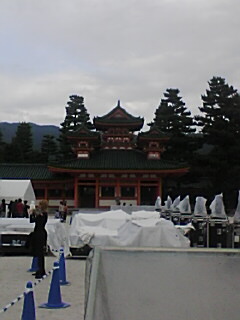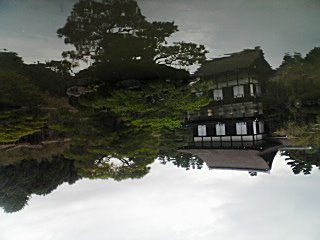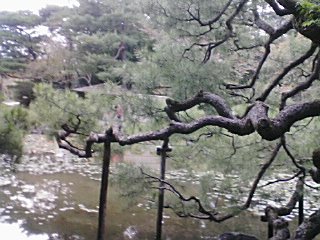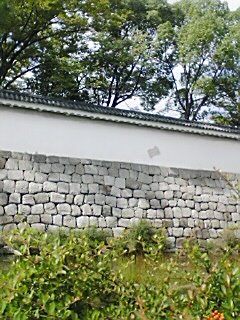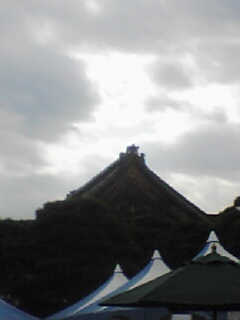The first part was a visit to Sanjuusan Temple (lit. Thirty-Three). No pictures allowed. Oh well. Here, 1001 life-size statues of Buddah exist. The bodies of each have 20 hands, each which represents 50 words (1000 words). Interesting that that means each statue is worth 1000 words? Possible etymological roots from the common source of India (like Indo-European). Might be a stretch. But an interesting coincidence at very least. Each statue is hand-carved wood, with the arms made and fitted separately, then the whole thing is guilded. That's for 1000 of these statues. Each face is different, and most are at least 850 years old, some over 1000 years old. It is kept fairly dark, but you can see many thousands of spikes from their crowns prickling the long room as you enter.
There are also a number of other natural treasures, larger "guardian" gods. The Storm god looks like he's giving the formal salute of "Bob." Just that would have been worth it alone, not that the thing wasn't worth it in every way!
At the center of the whole thing is the 1001st statue, a gigantic buddah sitting in a lotus with a volume greater than my kitchen. All guilded, with candles and incense everywhere. This temple, as the arrows and histories show, hosted Kyuu-do (Archery) contests for Samurai from all over Japan for a long time. The world's record is also around 1000 years old, held by a Samurai that for this (24 hour long!) contest of skill, shot about 86% of 13,000-something arrows in the uncomfortable position that Kyuu-do requires of it's archers.
Between this and Kiomizu Temple, we learned a couple things:
These 5 bars mean the highest level of temples. This was one created under the mandates of the "Monk Emperor" of about 1000 years ago. Kyoto was the center of Japan at the time, and capital. He was so religious that he decided that in addition to being emperor, it was also his duty to become a priest. He remained priest even after his appointment as emperor had finished and the duties had been passed on.

There are over 330 shrines and temples in Kyoto. Wowies. Like the Vatican of Japan. This was just another that we passed among many.

Finally, we stopped off at Kiomizu. You have to hike up a large part of the mountain to get to it, at a point about 1/2 way up the mountain. The shops LINE the narrow streets, trying to pick off tourists everywhere. We ignored them. Then we came to the main gate of Kiomizu temple. Mizu means water. Likewise, this temple is revered for it's 3 springs that when drank supposedly grant (depending on which you drink from) Wealth, Health, or Romantic Prosperity. It is now known that these water sources for the shrine actually all have the same origin, but the tradition remains regardless. Traditionally, people will travel to Kyoto just to get a drink from one of the three, from which many stories of morality, folly, and tales of wisdom are surely scupted from. This place is so well-known that some common metaphors and phrases in the Japanese language contain this places name and some of its more remarkable features.
Here is the main gate.

I could see a nice tower in the background, so I tried to get a shot of it while fighting through the crowd.

This one turned out better though.

I made it up to the tower, and between photo-ops of different groups, I managed to get a great picture of this pagoda, all 3 stories of glory and interesting modification for a lightning rod that seems very suitably traditional. Nobody in the picture, thanks to the group rotations on the scene. Lu-cky!

I managed to get another after the people had flooded back in, so I took it from a more distant point and a different angle.
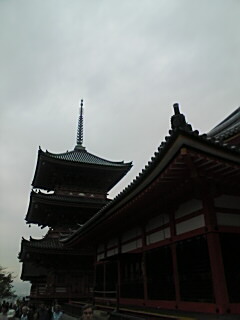
This is another beautiful building on the temple grounds.

And another.
We walked past that last one to the veranda, a sloped balcony which is the source of many romances, and the phrase "I feel like jumping off of the Kiomizu Veranda balcony." What does that mean exactly?

It means that you are crazy. You'd hit and roll down that thing in a pile. They say that those that used to do it did it as a proof of the strength of their love and of the fate they believed that they had. Well, if I survived that, I'd sure believe that fate was on MY side! I turned away from the drop to look back at the Kyoto that we had ascendeded from. You can see Kyoto Tower there, with it's modern trappings, famous pollution protocols, and short buildings (they have maximum airspace height requirements that are very strict I understand). It was about to get dark.

A ways down the Veranda, I saw the famous spring below. Well, that is almost a survivable fall. Instead of jumping, we continued on. No jumpers today. Good. I'd rather keep my limbs and internal organs anyways. I don't feel I need to prove to Brandy that I can become vegetative for her in order to prove my love and that fate is on my side. Having her just makes that itself obvious to me anyways.
Night upon us, I turned back to Kyoto to see it pleasantly lit up with low-pollution lights. Harder to catch on camera? Yeah...especially considering the whole "night" thing.

We rounded around to the bottom by stairs towards the back edge of the Veranda. I managed to get a pretty good night piture of the spouts. You basically walk under these troughs covered in aroom that come out of the mountain, grad a UV-cleansed pole with a cup on the end, and take your once-a-year drink. Chosing wisely is a topic of much discussion. Since people go with family or friends usually, the air was abuzz over the wisdom of their fellows (or folly!) for chosing any one. None of them are "wrong answers" by themselves, and non e is intrinsically superior. Chosing the right one is a matter of importance since each is a blessing. I waited in line, got a drinking-rod, chose "health," deposited the stick, and left. Too much economic prosperity isn't a good thing for an educator, and without health, money means little. I already have a romantic blessing, so I had no reason to choose that one. So health was the way to go for me. Kyoko seemed impressed in some way.

When I asked my Japanese teacher, Nishi-sensei (also my English student, "Michiko-san," and the one who took me to to my first Buddist temple, Kongoo-ji) which she had picked, she smiled at me with a funny look and said: "I was greedy." I figured this meant "I chose 'wealth.'" I was mistaken. She explained: "I drank from all three!" Oh well. Funny, she had told me earlier that she had her health, and she obviously has some wealth, and of course wouldn't mention romance in public directly, but...wow! I sure was surprised. But, it is a sensei's responsibility to take the fall if something goes wrong. I'm just surprised by her "phasing of her good judgement." So she felt she had to fess up to me as her teacher. Amazing how the rush of power from this old religious rite can invest people with a true power-trip due to greed o f what is right at hand. Doesn't really hurt anyone, but it was still interesting to see just how seriously people of Japan still believe in the power of these things.
Afterwards, we went to get some food, and we stopped at a restarant, a small place whose front room had 3 tables for two and one meant for 9. We of course took the big one and squeezed in about 12!
The center of the table was what made the place special...an enormous kettle holder over a large sand pit carved into the table. The kettle was large, but nothing unusual, as you'll see below.


And that beam stretches all the way to the opposite wall. This mangled prank of Pices has to be one of the most strangely unneccesarily elaborate things I have seen in my life. Still, it makes the place easy to find if I ever wanted to eat there again. It's the only one with THIS thing in it, I am sure, and it is the only one which you can see the potholder from angles you can't even begin to see the table!
So that was Kyoto. We didn't hardly scratch the surface, but I learned alot, and it was alot of fun.












